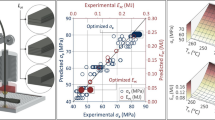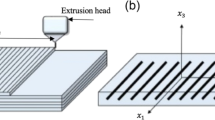Abstract
This paper shows the capability of friction-assisted tube straining (FATS) method to fabricate high-strength long tubes. For this reason, copper tubes were successfully processed via 1–7 passes of the FATS. Mechanical properties of the processed tubes were investigated via longitudinal and peripheral tensile tests. Polarize microscopy and scanning electron microscopy were executed to study microstructure evolutions. Finite element analysis was used to determine strain and temperature fields. Results show significant improvement in mechanical properties where flow stress, ultimate tensile stress, and microhardness increased 9.3, 1.8, and 2 times more than the initial values. Average grain size of the FATSed tube was significantly decreased to 1.4 μm from an initial value 30 μm after 7 passes. Investigation of the tensile properties of the longitudinal and the peripheral samples resulted in a maximum 19% anisotropy which was considerably improved comparison with the same SPD methods.











Similar content being viewed by others
References
Bagherpour E, Pardis N, Reihanian M et al (2018) An overview on severe plastic deformation: research status, techniques classifica- tion, microstructure evolution, and applications. Int J Adv Manuf Technol 12:1–49
Ahmadi F, Farzin M, Meratian M, Loeian SM, Forouzan MR (2015) Improvement ofECAP process by imposing ultrasonic vi- brations. Int J Adv Manuf Technol 79:1–4503–1–4512
Edalati K, Horita Z (2010) Continuous high-pressure torsion. J Mater Sci 45(17):4578–4582
Khatami R, Fattah-alhosseini A, Mazaheri Y, Keshavarz MK, Haghshenas M (2017) Microstructural evolution and mechanical properties of ultrafine grained AA2024 processed by accumulative roll bonding. Int J Adv Manuf Technol 93(1–4):681–689
Pardis N, Chen C, Ebrahimi R, Toth LS, Gu CF, Beausir B, Kommel L (2015) Microstructure, texture and mechanical properties of cyclic expansion-extrusion deformed pure copper. Mater Sci Eng A 628:423–432
Gibson B, Lammlein D, Prater T, Longhurst W, Cox C, et. al. (2014) Friction stir welding: process, automation, and control. J of Manuf Process 16:56–73
Toth L, Arzaghi M, Fundenberger J, Beausir B, Bouaziz O, Arruffatmassion R (2009) Severe plastic deformation of metals by high-pressure tube twisting. Scr Mater 60:175–177
Farshidi MH, Kazeminezhad M (2012) Deformation behavior of 6061 aluminum alloy through tube channel pressing : severe plastic deformation. J of Mater Eng and Perform 21:2099–2105
Babaei A, Mashhadi MM, Jafarzadeh H (2014) Tube cyclic extrusion-compression (TCEC) as a novel severe plastic deformation method for cylindrical tubes. Mater Sci Eng A 598:1–6
Hosseini SH, Sedighi M (2018) Thermo-mechanical modeling and microstructure evolution offriction-assisted tube-straining method. Int J Adv ManufTechnol:1–11
Hosseini SH, Sedighi M (2016) On the feasibility of a novel severe plastic deformation method for cylindrical tubes: friction assisted tubular channel pressing (FATCP). J Mech Sci Technol 30:5153–5157
Hosseini SH, Sedighi M (2019) An analytical coupled thermo-mechanical solution for friction assisted tube straining method. Int J Adv Manuf Technol 30:1–16
Dick CP, Korkolis YP (2014) Mechanics and full-field deformation study of the ring hoop tension test. Int J Solids Struct 51(18):3042–3057
User CAE 2013 Abaqus 6.13, analysis user guide. Dassault Syst
Kocks UF (1976) Laws for work-hardening and low- temperature Creep. J Eng Mater Technol 98:76–85
Ding R, Guo ZX (2001) Coupled quantitative simulation of microstructural evolution and plastic flow during dynamic recrystallization. Acta Mater 49:3163–3175
Lee HW, Im Y-T (2010) Cellular automata modeling of grain coarsening and refinement during the dynamic recrystallization of pure copper. Mater Trans 51:1614–1620
Powell RW, Ho CY, Liley PE (1966) Thermal conductivity of selected materials. Washington: U.S. Dept. of Commerce, National Bureau of Standards; for sale by the Superintendent of Documents, U.S. Govt. Print. Off
Cartigueyen S, Sukesh OP, Mahadevan K (2014) Numerical and experimental investigations of heat generation during friction stir processing of copper. Procedia Eng 97:1069–1078
Zhang H (2016) Numerical modeling of heat transfer and material flow during friction extrusion process. University of South Carolina, Columbia
Fagan T (2015) Computational modelling of friction stir processing. MONASH University, Clayton
Chao YJ, Qi X, Tang W (2003) Heat transfer in friction stir welding—experimental and numerical studies. J Manuf Sci Eng 125:138
Baffari D, Buffa G, Fratini L (2017) A numerical model for wire integrity prediction in friction stir extrusion of magnesium alloys. J Mater Process Technol 247:1–10
Hosseini SH, Sedighi M (2018) Novel friction-assisted tube forming methods: a comparison of microstructure and mechanical properties. J ManufSci Eng 140:101008
De Jaeger J, Solas D, Fandeur O, Schmitt J-H, Rey C (2015) 3D numerical modeling of dynamic recrystallization under hot working: application to Inconel 718. Mater Sci Eng A 646:33–44
Cartigueyen S, Mahadevan K (2015) Influence of rotational speed on the formation of friction stir processed zone in pure copper at low-heat input conditions. J Manuf Process 18:124–130
Xue P, Wang BB, Chen FF, Wang WG, Xiao BL, Ma ZY (2016) Microstructure and mechanical properties of friction stir processed Cu with an ideal ultrafine-grained structure. Mater Character 121:187–194
Tavakkoli V, Afrasiab M, Faraji G, Mashhadi MM (2014) Severe mechanical anisotropy of high-strength ultrafine grained Cu-Zn tubes processed by parallel tubular channel angular pressing ( PTCAP). Mater Sci Eng A 625:50–55
Dalla Torre F, Lapovok R, Sandlin J, Thomson PF, Davies CHJ, Pereloma EV (2004) Microstructures and properties of copper processed by equal channel angular extrusion for 1-16 passes. Acta Mater 52(16):4819–4832
Author information
Authors and Affiliations
Corresponding author
Ethics declarations
Conflict of interest
The authors declare that they have no conflict of interest.
Additional information
Publisher’s note
Springer Nature remains neutral with regard to jurisdictional claims in published maps and institutional affiliations.
Rights and permissions
About this article
Cite this article
Hosseini, S.H., Sedighi, M. Applicability of friction-assisted tube straining method to produce high-strength copper tubes. Int J Adv Manuf Technol 106, 3931–3941 (2020). https://doi.org/10.1007/s00170-019-04912-7
Received:
Accepted:
Published:
Issue Date:
DOI: https://doi.org/10.1007/s00170-019-04912-7




